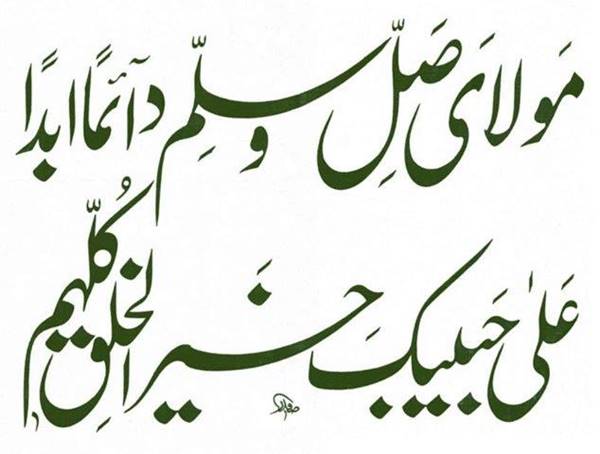4 More Qawwalis by Farid Ayaz & Abu Muhammad Qawwal: Letter by Wazir Dayers
This evening I’m sending you four more soul-stirring Qawwalis by the superb Ustad Farid Ayaz & Abu Muhammad Qawwal:
1) Mawlāya, Salli Wa Sallim Dā’iman Abadan ‘Alā Habībika Khayr-il-Khalqi Kullihimi (Burda Sharīf)
The refrain of this qawwali comes from a famous medieval Arabic poem in praise of Hazrat Muhammad, called “Qasīdat-ul-Burda” (“The Poem of the [Prophet’s] Mantle”). It was written in the 13th century CE by the eminent Egyptian Sufi Shaykh and poet Imam Sharafuddin Muhammad al-Busiri (ca. 1212–1296 CE – R.A.), who belonged to the Shadhili Sufi Order.
In this ode to the Holy Prophet, Shaykh al-Busiri (R.A.) tells how he had become afflicted with paralysis, and how the Holy Prophet (Blessings and Peace Be Upon Him) cured him by coming to al-Busiri in a dream and covering him with his mantle.
The refrain is translated as follows: “My Lord, continuously and eternally bestow Blessings and Peace on Your Beloved, the Best of All Creation”!
Ustad Farid Ayaz & Abu Muhammad Qawwal only sing the first part of the refrain (“Mawlāya, Salli Wa Sallim Dā’iman Abadan”), but they sing it with great fervour.
2) Mera Sarkar Aaye
“My Master (or Lord) Has Come!” – a magnificent Qawwali celebrating the birth of Hazrat Muhammad (Blessings and Peace Be Upon Him),welcoming Allah’s Beloved into this world with immense love and joy.
3) Nami Danam Cheh Manzil Bood Shab Jaye Keh Man Boodam
Here’s an English translation of this Persian classic of Hazrat Amir Khusrau (R.A):
“I don’t know what place it was, where I was the other night
Victims of the Dance of Slaughter* lay in every direction, where I was the other night
There was a nymph-like Beloved with a cypress-like form and a tulip-like face,
Causing hearts to suffer utter torment**, where I was the other night
Rivals competed with their voices, He was full of coquetry***, and I was filled with fear
It was so difficult to speak, where I was the other night
God Himself presided over the assembly, and Khusrau (or Khusrō) was in lā makān****
The fire of Your Love has burnt my soul, O Khusrō!*****
Muhammad (S.A.W.S.) was the Burning Candle that lit up the gathering, where I was the other night”
* “Raqs-e-Bismil” – “The Dance of Slaughter”. This may refer (I’m not 100% sure) to people who go into ecstasy during ritual Sufi gatherings, and start to move uncontrollably. The Sufi term for this involuntary movement is “raqs”, literally meaning “dance”. This movement is caused by the attraction exerted by the Divine Being. Another explanation that I’ve read somewhere (can’t remember where) is this: “Bismil is the name given to the lamb which is about to be slaughtered in the name of Allah. So Raqs-e-Bismil is the twitching of the lamb while being slaughtered.”
** Literally “disaster” (‘āfat)
*** In Sufism, a Master often plays the game of “Nāz-o-Niyāz”: the Master attracts the mureed (Sufi disciple) in all kinds of ways (= “nāz” – “coquetry”) and then pushes him away, in order to increase the mureed’s longing and need for the Master’s Love and attention (“niyāz”) even more. This really is the Sufi version of “playing hard to get”!
**** Lā makān: in Arabic this literally means “no place”, or “spaceless space”, i.e. “the Placeless Realm”, the place of the deity, where there is no space and time, a state beyond our conception.
***** Here Ustad Farid Ayaz Qawwal inserts a Persian verse that I haven’t heard in any other performance of this poem.
4) Rang – Aaj Rang Hai E Maa(n), Rang Hai Ri [Kalam Hazrat Amir Khusro]
To end this series of qawwalis by Ustad Farid Ayaz & Abu Muhammad Qawwal, I send you another rendition of Hazrat Amir Khusrau’s “Rang”. Here’s an English translation of the “Rang”* (“Aaj Rang Hai E Maa(n), Rang Hai Ri”):
“What a Glow do I see now, O Mother, what a Glow!
See the Glow in my courtyard [i.e. “in his innermost being”, “in his heart”]!
I have found my Pīr, Nijamuddin Auliya! [“Pīr” is the Persian word for “Sufi Master”]
I roamed around the entire world, looking for an Ideal Beloved
And finally this Face has enchanted my heart
The whole world has been opened for me
Never have I seen a Glow like this before
Whenever I see now, he is with me,
Oh Beloved, please dye me in yourself [i.e. “in your own Glow/Colour”]
Dye me in the Colour of Spring, Beloved!
What a Glow, O what a Glow!”
* The term Rang designates a special quality of a Sufi Master or Saint. “Rang” literally means “colour”, “dye” or “hue”, but there’s much more to it. “Rang” can only be described. I describe it as “the Glow of the Inner Essence of the Master”. I don’t know a better way to describe it.
Dear Brother, may listening to these qawwalis bring you much joy!
Wazir
PS: I don’t know when and where these four qawwalis were recorded, nor do I remember where I got them. They’re just part of my music collection. I’ve classified them as “Ustad Farid Ayaz & Ustad Abu Muhammad Qawwal – Miscellaneous”.






